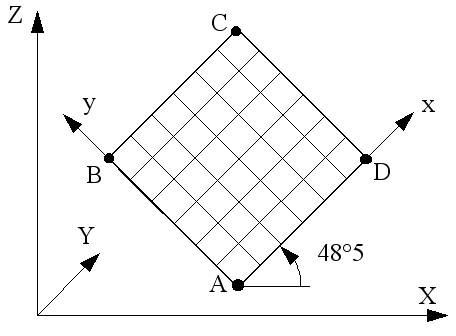6. D modeling#
6.1. Characteristics of modeling#
6.2. Characteristics of the mesh#
Number of knots: 49
Number of meshes and types: 36 QUAD4
6.3. Tested sizes and results#
Identification |
Reference type |
Reference values |
Tolerance \((\text{\%})\) |
|
\(w(\mathrm{0,}\mathrm{0,}0)\) |
|
0.01507 |
1.1 |
|
\(\mathrm{SIXX}(\mathrm{0,}\mathrm{0,}h/2)\) |
|
2.4216 107 |
1.1 |
|
\(\mathrm{SIYY}(\mathrm{0,}\mathrm{0,}h/6)\) layer to \(90°\) |
SOURCE_EXTERNE |
5.7810 106 |
5.7810 106 |
1.1 |
\(\mathrm{SIXY}(a/\mathrm{2,}a/\mathrm{2,}h/2)\) |
|
1.2825 106 |
7.1 |
|
\(\mathrm{SIXZ}(a/\mathrm{2,}\mathrm{0,}0)\) |
|
—2.3526 105 |
||
\(\mathrm{SIYZ}(\mathrm{0,}a/\mathrm{2,}0)\) |
|
8.8950 104 |
2.1 |
6.4. notes#
The components \(\mathrm{SIXX}\), \(\mathrm{SIYY}\), and \(\mathrm{SIYZ}\) are the average values of the two cells competing at points \(A\) and \(C\).
The difference obtained on \(\mathrm{SIXZ}\) is due to the difference in transverse shear modeling: in the reference, a transverse shear correction coefficient of 5/6 is used. In Code_Aster, we calculate the distribution of shear in the thickness, which is assumed to be parabolic in each layer.
The sign of \(\mathrm{SIXZ}\) is the opposite of that of the reference solution.
